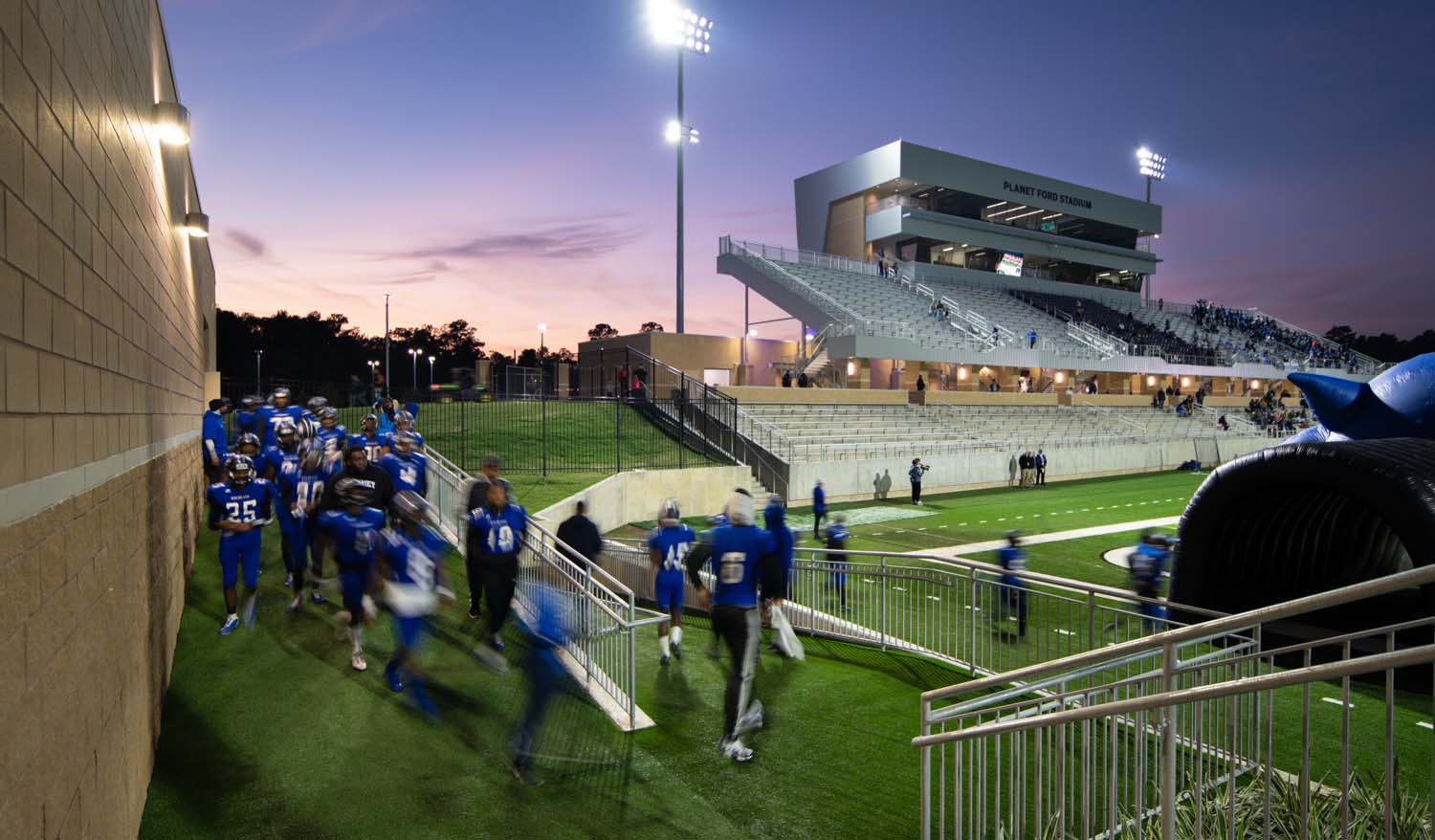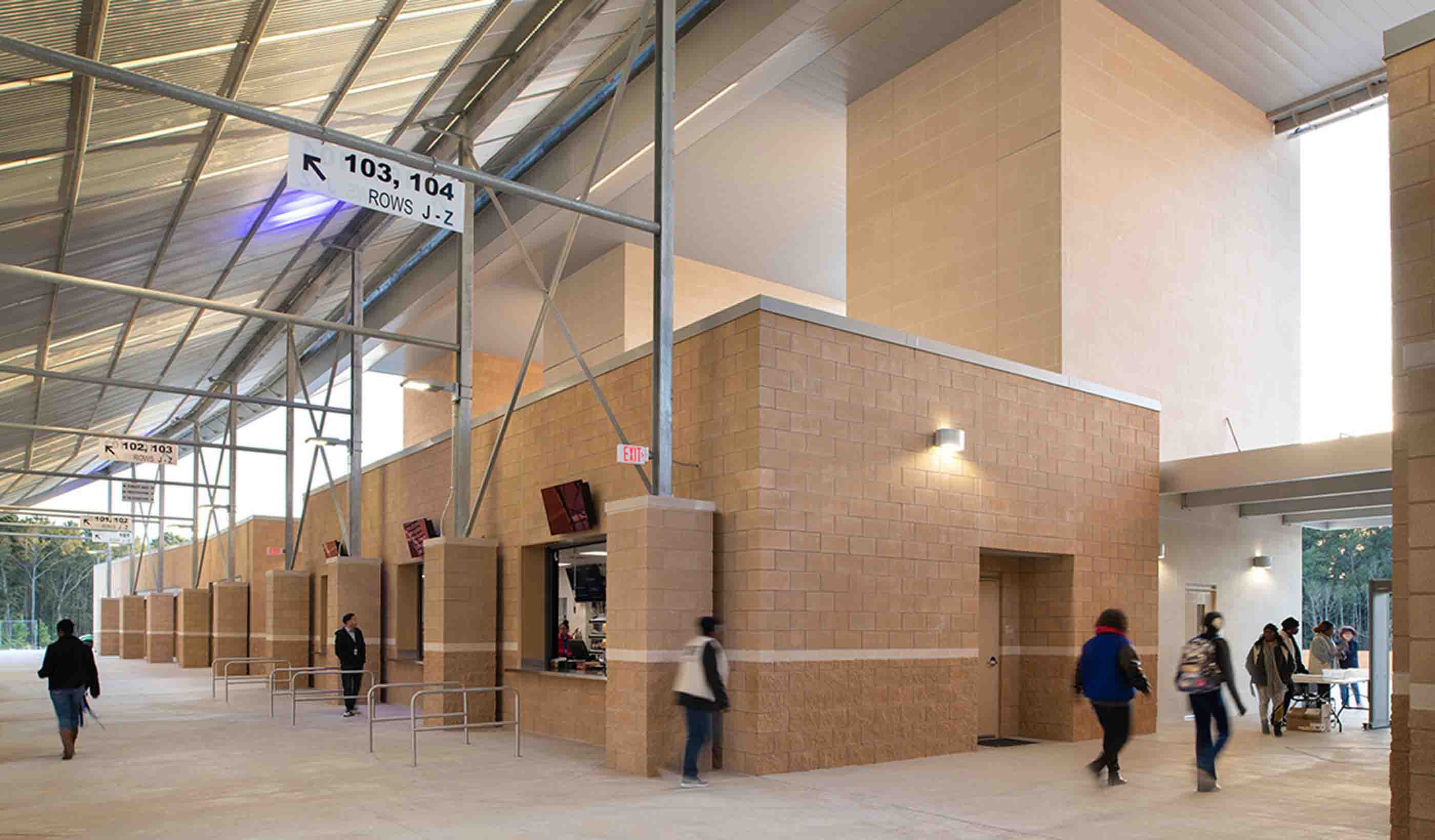6 factors when planning a school sports facility
September 09, 2021
September 09, 2021
Modern educational sports facility design holistically considers the full user experience, revenue-generation opportunities, expandability, and more
In 2020, I aimed to seek out more opportunities for connecting the dots between modern athletic facility design trends and how these facilities impact both the learning environment and our local communities.
Excited to get started, I hit the ground running with Friday Night Lights: The architecture of high school football stadium design in Texas to discuss the evolution of stadium features and amenities that can contribute to design costs today.
I looked forward to sharing more insights as the year continued and had barely let the metaphorical ink dry before diving into my next blog. Then, as I was heading into the home stretch with my draft, the entire world changed.
The education system swiftly felt the impacts of COVID-19. Educators and learners alike were experiencing a major shift practically overnight. School districts suddenly needed to develop all new protocols to ensure a safe and healthy return for their students and staff. And parents were having to help fill in the gaps while also navigating significant changes to their own routines and responsibilities.

Home and visitor teams access the field at Planet Ford Stadium from fully enclosed and separate entrances.
As many settled into the new norm of online learning and working from home, it quickly became clear that living in a virtual world meant losing one thing that just plain works better in a physical one: sports. (Anyone else remember marble races, belly flopping contests, and watching people play video game sports on ESPN as the network scrambled to fill their suddenly empty airtime?) Social distancing and other health and safety precautions were redefining our behaviors, prompting us to take a step back and examine what that meant for sports facilities.
Today, with the kickoff of a new school year, there is an increased confidence to continue forward with new facilities. Here are 6 factors when planning your next project:
The most important concern when designing a sports facility is the user. Creating an ideal experience requires thinking about everyone. That includes the athletes, coaches, and spectators along with the security officers, facility operators, and maintenance crew.
Providing safe and customized practice and gameplay environments helps motivate athletes and teams for the big event. A well-organized facility that lets spectators move seamlessly from their vehicle or public transport to a clear entry, enjoy the event, and exit the facility quickly allows them to enjoy an exciting and stress-free experience.
The best approach is to keep spectators and student athletes from mixing with each other since athletic events can sometimes be very emotional. An ideal facility has separate home and visitor entries, as well as separate entrances for players. Referees and umpires should have a clear path to a locker room without mixing with any of the groups. Security needs proper visibility and sight lines to allow for easily observing the entire facility.
Behind the scenes, support staff—including concession workers, custodial staff, security, and medical personnel—also need adequate space in the right locations to complete their tasks without impacting the athlete or spectator experience. This can include kitchen facilities and other food-service support space, first aid rooms, and even holding rooms for anyone who gets too out of hand while on-site security waits for backup.

Located within Del Valle High School Athletic Facility’s public lobby and reception area, the Wall of Champions utilizes bold graphics and branding to celebrate athletic program accomplishments and strengthen students’ connection to the school.
We’ve previously explored how participating in sports not only helps student athletes develop important life skills but can also positively influence their social and economic futures, but did you know a sports facility can serve more than just student athletes? Many athletic complexes today simulate real-world experiences that support learning for sports-adjacent careers. Those include marketing, broadcast, technology, physical training, physical therapy, culinary, and event management. Some districts have even developed programs that pay students to operate the scoreboard, including creating commercials and instant replays, which provide them with real-world learning opportunities and actual job experience.
Lastly, facility and field rentals present another opportunity for revenue generation. Districts can rent out their facilities to organizations that need a playable surface (like synthetic turf fields during rainy seasons, for example) or larger seating capacity than they might have on their home filed. Community rooms at stadium complexes typically seat 300-500 people and can be used for district functions as well as fundraisers, wedding receptions, public speakers, and birthdays.
There can be the misconception that funding for facilities in Texas takes priority over teachers’ salaries. This is not the case. Communities vote on bonds proposed by the school district to build or improve facilities. Per state law, once these funds are approved by voters, they cannot be used to pay for operational expenditures such as salaries. Additionally, legislation passed in 2019 gives communities the power to vote on athletic and performing arts facilities independently from the school bond. Then, once the bond is approved, athletic departments have other means of raising funds to help with maintenance, equipment costs, and travel.
In addition to avenues like ticket sales and premium seating options, facility naming rights can also create significant revenue. For example, a 5- or 10-year naming commitment for a stadium can generate up to six figures. Digital scoreboards also create an opportunity to air commercials, public announcements, and fan cams. Combining this with an option to secure a press box suite can bring in an additional $30,000-$40,000 annually.
Aquatics facilities, which are both expensive to build and operate, can be rented by the community for local swim clubs, swim instruction, or even scuba training to help offset maintenance costs. This does require planning and designing the pools to accommodate these activities; while a typical high school competition pool is a 25-yard, 8-lane pool that is at least 6 feet deep, a pool including swim instruction requires a shallow portion that will add length. A movable bulkhead makes the pool more multipurpose.
Social distancing and other health and safety precautions were redefining our behaviors, prompting us to take a step back and examine what that meant for sports facilities.
Site selection can have a large impact on how the facility functions and the cost of construction. Access is a major consideration when selecting a site that will serve thousands of spectators. We typically look for a site that has two access points from two thoroughfares that is adjacent to a major highway. This gives spectators more options and allows them to exit more quickly.
Topography conditions can have a large impact on construction costs. There is a presumption that a flat site is the best site. This can be partly true, but there are ways to take advantage of a sloped site to help improve the feel of a facility while maintaining a lower cost. For example, a concrete slab on a berm is very close to the cost of a traditional aluminum bleacher but has a better feel and can be top loaded for improved access (as outlined in the Americans with Disabilities Act).
Soil conditions can also drive up the cost. Sites with shallow groundwater conditions can prohibit a field from being lowered to take advantage of berm seating. It can also require structural piers to create a solid base for any constructed building. We recommend getting soil borings at any site before purchase to better understand how the soil will impact facility costs.
Creating a durable and easily maintainable building is important regardless of use, but it is particularly important in an educational facility. Almost every surface in an athletic facility—a highly active destination for athletes and spectators alike—needs to be durable and easy to clean. Using high quality, visually appealing materials in frequently utilized spaces, such as locker rooms, helps foster a sense of pride and personal responsibility in student athletes of all ages. They understand that this special place has been created for them and, as a result, are motivated to respect and take care of it.

Sight lines at Planet Ford Stadium allow security and district officials to survey the entire facility from one vantage point, drastically reducing the potential for user misconduct.
Maintenance areas are another great (but often overlooked) project component where an intentional design approach can promote a sense of commitment and connection to the facility. During the value engineering process, this seems to be space that gets displaced by another program until it is reduced to a bare minimum. As a result, the first complaint from many maintenance staff is, unsurprisingly, the lack of dedicated storage space for equipment and supplies. It’s important for the designer to maintain a list of all required maintenance equipment and ensure its full footprint is accurately shown in storage rooms. By providing enough dedicated space for these “less exciting” elements, you will ultimately create a more functional facility where maintenance can spend less time “MacGyvering” solutions and more time feeling productive and inspired to do their jobs well.
One of the worst mistakes a designer can make is to design themselves into a box without thinking about possible future expansion. This can include increased seating capacity—which would also impact restrooms, concessions, and parking—as well as future facility amenities.
Water retainage is also becoming an increasingly larger issue as communities become more developed. Detention and retention ponds are the most cost-effective way of dealing with watershed, but as facilities grow, there is less land available for that purpose. This requires more expensive solutions, such as underground detention.
Athletics are an integral piece of the learning experience in many school communities—but this is only one piece of the puzzle. Modern educational athletic facilities go beyond supporting the student-athlete population. They become anchor points for the entire community, promoting physical literacy and social vibrancy all year long. If we maximize their use, functionality, and shelf life, we will inspire people to bring their “A” game for generations to come.